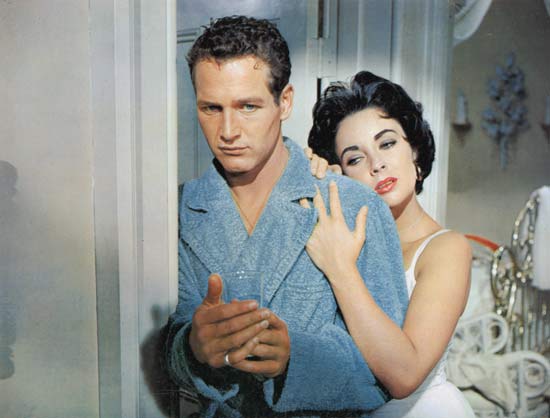By Dean Treadway
Contributing Blogger
CAT ON A HOT TIN ROOF (1965); based on the Tennessee Williams play; Dir: Richard Brooks; Screenplay by Richard Brooks and James Poe; Starring Elizabeth Taylor, Paul Newman, Burl Ives, Judith Anderson; Tues. July 12; pre-show at 7 PM/film at 7:30 p.m.; Coca-Cola Summer Film Festival at Fox Theatre. Trailer here.
 Surely, the recent passing of superstar Elizabeth Taylor is behind the programming of 1958’s CAT ON A HOT TIN ROOF at the Fabulous Fox on Tuesday, July 12. And it’s a good choice, too. Taylor’s sultry, skimpily-dressed Maggie The Cat is one of her most iconic performances, and is certainly the definitive filmed (or televised) portrayal of scribe Tennessee Williams’ most cunning heroine.
Surely, the recent passing of superstar Elizabeth Taylor is behind the programming of 1958’s CAT ON A HOT TIN ROOF at the Fabulous Fox on Tuesday, July 12. And it’s a good choice, too. Taylor’s sultry, skimpily-dressed Maggie The Cat is one of her most iconic performances, and is certainly the definitive filmed (or televised) portrayal of scribe Tennessee Williams’ most cunning heroine.
Still, the film version of Williams’ Pulitzer Prize-winning 1955 play could be better. In it, Paul Newman plays Maggie’s husband Brick, a former football star who’s literally been crippled by booze (he spends the whole film hobbled by crutches). Living on his bloated, bellowing father’s “plantation,” he’s constantly getting jabbed from all sides. His needling father and mother (the excellent Burl Ives and Judith Anderson) are wondering why he and Maggie don’t have any children while his brother Gooper (Jack Carson) has had a whole passel of kids with his woman (Madeleine Sherwood). Meanwhile, Maggie has moved into full seduction mode; the play takes place on a hot summer day, but that’s not the only reason she’s often seen in her skivvies. She’s trying all she can do to put the fire back into their romance. But Brick won’t have any of it; the idea of he and Maggie together has become distasteful to him, because he still blames her for driving his best friend to suicide.
The problem with the film comes with this final detail. In the original play, it was pretty clear that Brick and his friend, Skipper, were engaged in a homosexual relationship, and that Maggie slept with Skipper in order to break the duo up. But none of this is alluded to in the film, because it was 1958 and the studio, MGM, would have none of it. So the central conflict in the film is incapacitated, just like Brick (Williams himself was disappointed with the film version, telling the press that the movies “would set the industry back 50 years“). And yet Paul Newman wisely conveys some pained undertones that let us know what was REALLY going on.
The film bogs down in its middle, too, but it’s always handsome to look at, thanks to the Oscar-nominated color cinematography by William Daniels. And it boasts of one of the finest supporting performances in any Tennessee Williams adaptation: that of Burl Ives, reprising his Broadway triumph as the imposing Big Daddy Tabbitt, bemoaning the family’s danged “mendacity” while suffering, as a terminal case, through what might be his last birthday celebration. Somehow, Ives escaped an Oscar nomination himself, but Taylor and Newman got one, as did the film, its director (Richard Brooks) and its screenplay (by Brooks and James Poe).
In the end, although it’s not entirely successful, the main reason to see CAT ON A HOT TIN ROOF is for Ives and for Taylor. Both are forces of nature, but for wildly different reasons, of course. Ives blusters magnificently, while Taylor slinks around like the beautiful cat she is. The Fabulous Fox is the place to be on Tuesday, July 12 (the pre-show, with the Mighty Mo singalong, cartoon and trailers, starts at 7 p.m.); one cannot miss a chance to see the stunning Elizabeth Taylor writ large on the big screen, where her beauty and talent were always meant to be experienced.
Dean Treadway is a longtime Atlanta film analyst and film festival programmer with more than 25 years of published works. His popular film blog is called filmicability with Dean Treadway and can be perused here at https://www.filmicability.blogspot.com/. He is also a correspondent for Movie Geeks United, the Internet’s #1 movie-related podcast, at https://www.blogtalkradio.com/moviegeeksunited.

